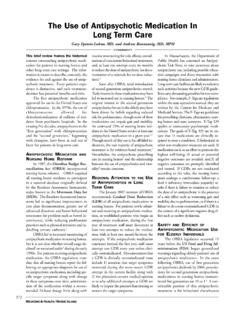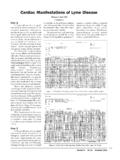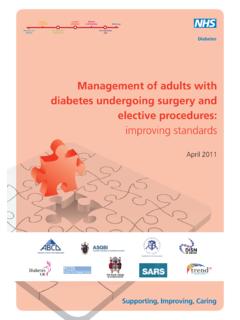Transcription of Asymptomatic carotid stenosis: screening and management
1 89 Volume 94 No. 4 April 2011 Asymptomatic carotid stenosis : screening and managementJonathan A. Grossberg, MD, N. Stevenson Potter, MD, PhD, and Mahesh V. Jayaraman, MDthe management of Asymptomatic carotid stenosis can be a dilemma to the primary care physician. In this review, we hope to update the reader on current insights into Asymptomatic carotid stenosis is defined as the atherosclerotic narrowing of the proximal internal carotid artery exceeding 70% in severe cases and 50% in moderate cases. The prevalence of carotid stenosis in Western countries increases with age. A recent Western European population study placed the prevalence of moder-ate Asymptomatic stenosis at and severe stenosis at The prevalence was found to increase with age and be higher in males, with of men being diagnosed with moderate first described the pathophysi-ology of carotid atherosclerosis in Since then it has increasingly been recog-nized as a risk factor and cause of stroke.
2 A population based study of subjects older than 55 found that the presence of a severe carotid plaque burden increased the relative risk of a non-lacunar infarc-tion in the anterior circulation by times and increased the risk of a lacunar infarction by Accordingly, Asymptomatic carotid stenosis has become an important cerebrovascular topic for the primary care physician. Wh A t i s t h e b e s t s C r e e n i n g t e s t f o r C Ar o t i d A r t e r y s t e n o s i s?The diagnosis of Asymptomatic carotid stenosis classically begins in the outpatient office. Many primary care phy-sicians will examine patients for the pres-ence of a carotid bruit, which is thought to signify turbulent blood flow across a stenotic plaque.
3 While the Framingham Heart Study found that patients with a carotid bruit had double the stroke rate of controls, the majority of these strokes were in vascular territories unrelated to the Another large meta-analysis found a significantly increased risk of myocardial infarction and cardiovascular death in patients with a carotid bruit, thus implying that the bruit is best used as a marker for total body atherosclerotic dis-ease and not as a direct marker of carotid A recent cohort study examined the incidence of carotid bruit and clini-cally significant stenosis on carotid duplex and found that bruit auscultation had a sensitivity of 56% and a specificity of 98%.
4 From the analysis of their data, the authors concluded that the auscultation was not sufficient to exclude stenosis , and further invasive testing should be consid-ered in high-risk physical exam has a low prob-ability of diagnosing Asymptomatic carotid stenosis , the diagnosis is often made through a variety of non-invasive radiological exams, namely duplex ultrasonography (DUS), computed tomographic angiography (CTA), and magnetic resonance angiography (MRA). DUS is often the first screening test done due to its ease of use, lack of radiation or need for contrast material and cost.
5 A review of non-invasive imaging found that DUS had an 86% sensitivity and 87% specificity for diagnosing clini-cally significant (>70%) One drawback of DUS is that it is operator dependent, and operator experience can affect the accuracy of results. In addition, the utility of DUS in screening patients without any risk factors for atherosclerotic disease is low, and screening the general population may not be cost-effective. Bet-ter results were found using MRA for the detection of clinically significant stenosis with a sensitivity of 95% and a specificity of 90%.7 In another recent meta-analysis, CTA was found to have a sensitivity of 76% and a specificity of 94%.
6 This study also found that contrast-enhanced MRA had the best sensitivity (94%) and specific-ity (93%) when compared to DUS, CTA, and non-contrast One potential advantage of MRA over CTA is that dense calcification from some carotid plaque can limit luminal evaluation on CTA. While catheter angiography is the gold standard for evaluation of carotid stenosis , the cost, more invasive nature and potential for neurologic complications have rel-egated it to a problem-solving role when significant discrepancies exist among the non-invasive imaging techniques. In patients with known carotid disease, the optimal interval for repeating DUS is unknown, but it is likely reasonable to repeat the study annually to monitor for interval change.
7 Ho W s h o u l d A p A t i e n t W i t h A s y m p t o mA t i C C Ar o t i d A r t e r y s t e n o s i s b e f o l l oW e d A n d W h e n s h o u l d t h e y b e r e f e r r e d f o r r e vA s C u lA r i zA t i o n?medical therapyFor the majority of Asymptomatic patients with carotid stenosis the ideal treatment is a combination of risk factor modification and anti-platelet medica-tion. The risk factors targeted are familiar to all clinicians and include hypertension, smoking, physical inactivity, obesity, hy-perlipidemia, and glycemic a number of these risk fac-tors can be modified through lifestyle changes, particular attention has been paid to pharmacological treatments for hyperlipidemia and hypertension and their direct effect on carotid atherosclero-sis.
8 It is well known that the use of statins to meet cholesterol goals reduces the risk of stroke, but there is also evidence that statins may impact carotid plaque A recent study reviewed the effect of statins on atherosclerotic burden by randomizing patients to low-dose versus high-dose statin therapy. All patients in the trial had a significant reduction in radiologic atherosclerotic burden by 12 months, and post-hoc analysis revealed that the change was more related to the low LDL level induced by statin therapy than to the medication Another more recent study found that statin use in symptom-atic carotid patients was associated with a decreased incidence of negative plaque features on MR imaging.
9 These negative plaque features are thought to be predic-tive of future cerebrovascular events and include intraplaque hemorrhage, necrotic 90mediciNe & HeAltH/rHode islANdcore, and a thin fibrous In addi-tion, there is some evidence that certain anti-hypertensive medications can have positive effects on the morphology of carotid plaques. A more detailed review of the effect of various medications on plaque morphology is beyond the scope of this paper and can be found in the review by Daskalopoulou et The literature, however, is not conclusive so the recom-mendation is that patients be treated with anti-hypertensive medications that best fit their other addition to risk factor and lifestyle modifications, it is the consensus of the American Stroke Association (ASA)
10 That patients with Asymptomatic carotid stenosis be treated with While good data exist for recommending aspirin and other anti-platelet agents to patients with a history of an ischemic cerebrovas-cular or cardiovascular event, there are no adequate studies examining aspirin in patients with Asymptomatic carotid This ASA recommendation for aspirin derives from the fact that nearly all trials comparing outcomes of medical management to surgical management for carotid stenosis treat patients with aspirin. While the ASA does give a class I evidence rating to the use of aspirin, there are no studies that provide class I data for the use of other antiplatelet agents in the manage-ment of Asymptomatic carotid stenosis .



